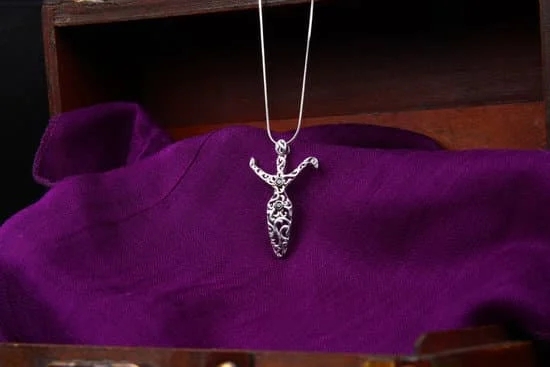Are you an aspiring jewelry maker wondering how to price your silver handmade jewelry? Pricing your creations can be a daunting task, but understanding the value of your handmade silver jewelry is essential in setting the right price point. In this article, we will explore the various factors and strategies involved in pricing your silver handmade jewelry effectively.
Handmade silver jewelry holds a unique value that goes beyond just the cost of materials and labor. The craftsmanship, creativity, and personal touch that goes into each piece make it truly special. Understanding this inherent value is crucial in determining the pricing for your creations.
In the following sections, we will delve into the factors to consider when pricing your handmade silver jewelry, from calculating the cost of materials and labor to determining market demand and setting the right markup for profit. Additionally, we will discuss strategies for effectively communicating the value of your handmade silver jewelry to customers. Whether you’re just starting out or looking to refine your pricing strategy, this article will provide valuable insights for pricing your unique handmade silver jewelry.
Factors to Consider When Pricing Your Handmade Silver Jewelry
When it comes to pricing your handmade silver jewelry, there are several factors to consider in order to ensure that you are setting a fair and competitive price for your unique creations. By taking into account these important considerations, you can make sure that you are not undervaluing your work or alienating potential customers with unreasonably high prices.
Quality of Materials
One of the first factors to consider when pricing your handmade silver jewelry is the quality of materials used. Higher quality materials will naturally demand a higher price, so be sure to calculate the cost of your materials accurately. This includes not only the silver itself, but also any gemstones or other embellishments that are incorporated into your designs.
Labor and Time
Another crucial factor in pricing your handmade silver jewelry is the amount of time and labor that goes into each piece. Consider how long it takes to create each design, including planning, crafting, and finishing. You may want to assign an hourly rate for your work in order to accurately reflect the time and effort put into each piece.
Design Complexity
The complexity of your designs should also be taken into consideration when determining pricing for your handmade silver jewelry. Intricate designs or pieces that require specialized techniques should command a higher price than simpler, more straightforward designs. Customers will be willing to pay more for unique and meticulously crafted pieces.
By carefully considering these factors – the quality of materials, labor and time, and design complexity – you can ensure that you are pricing your handmade silver jewelry fairly while also reflecting its true value in the market. Understanding how these elements contribute to the overall worth of your creations will help you determine a competitive yet profitable pricing strategy for your business.
Calculating the Cost of Materials and Labor
When it comes to pricing your handmade silver jewelry, one of the most important factors to consider is the cost of materials and labor. Calculating these costs accurately will ensure that you are able to set a price that not only covers your expenses but also allows you to make a profit. Here are some steps on how to price your silver handmade jewelry by calculating the cost of materials and labor:
- Make a list of all the materials used in each piece of jewelry: This includes the silver, gemstones, beads, clasps, and any other components used in the creation of your jewelry. Be sure to include even small items such as jump rings and earring backs.
- Determine the cost of each material: Once you have a list of all the materials used, calculate the cost of each item. Keep track of how much you paid for each material so that you can accurately calculate the total material cost for each piece.
- Calculate the cost of labor: Consider how long it takes you to create each piece and what an hourly rate for your work should be. Factor in any additional costs such as tool maintenance or utilities used in production.
By following these steps, you can accurately calculate the cost of materials and labor for each piece of handmade silver jewelry. This will allow you to set a price that reflects these expenses while still remaining competitive in the market.
Determining the Market Demand for Silver Jewelry
When pricing your handmade silver jewelry, one crucial factor to consider is the market demand for silver jewelry. Understanding the demand for your products will help you set prices that are competitive and appealing to your target customers. Here’s how to assess the market demand for silver jewelry and use it to your advantage in pricing your pieces.
First, research the current trends in silver jewelry. What styles, designs, and types of silver jewelry are popular at the moment? Look at fashion magazines, online marketplaces, and social media platforms to see what styles are getting attention. Additionally, you can visit local jewelry stores or craft fairs to see what kinds of silver jewelry are selling well.
Next, consider your target market. Who are the people most likely to buy your handmade silver jewelry? Are they young adults looking for trendy pieces, or are they older individuals with a preference for classic designs? Understanding your target market’s preferences will help you tailor your designs and pricing to meet their needs.
Finally, gather feedback from potential customers to gauge their interest in your handmade silver jewelry. You can do this through surveys, social media polls, or by simply asking friends and family for their thoughts. By understanding what potential customers want and are willing to pay for, you can adjust your pricing strategy accordingly.
| Market Demand Factors | Considerations |
|---|---|
| Current Trends | Research popular styles and designs |
| Target Market Preferences | Understand who is most likely to buy your jewelry |
| Gathering Feedback | Survey potential customers to gauge interest |
Strategies for Pricing Your Handmade Silver Jewelry Competitively
When it comes to pricing your handmade silver jewelry, it’s important to consider various strategies to ensure that your products are competitive in the market. Here are some key strategies you can use to set the right price for your unique creations.
Researching the Market
Before setting the price for your handmade silver jewelry, it’s crucial to conduct thorough research on the current market trends and prices. Take a look at what similar pieces are selling for in both online and offline marketplaces. This will give you an idea of the price range that customers are willing to pay for handmade silver jewelry, and help you stay competitive without undervaluing your products.
Quality vs. Price
One of the challenges of pricing handmade silver jewelry is balancing quality with affordability. While it’s important to consider the cost of materials and labor, it’s equally crucial to communicate the value of your craftsmanship and unique designs. Emphasize the quality and craftsmanship behind each piece when determining a fair price, as this will help customers understand why your jewelry is worth the investment.
Offering Customization Options
Another strategy for pricing your handmade silver jewelry competitively is to offer customization options. By allowing customers to tailor their pieces according to their preferences, you can justify a higher price point for personalized designs. Additionally, customization adds value and exclusivity to your jewelry, making them more appealing in a competitive market.
By implementing these strategies, you can ensure that you’re pricing your handmade silver jewelry competitively without compromising on quality or undervaluing your craft. As you navigate through the process of setting prices for your unique creations, keep in mind that effectively communicating the value of your products is just as important as determining a fair price based on market demand and cost considerations.
The Impact of Branding and Uniqueness on Pricing
When it comes to pricing your silver handmade jewelry, the impact of branding and uniqueness cannot be overlooked. Your brand and the uniqueness of your pieces can greatly affect the perceived value and, as a result, the price you can command for your jewelry.
Branding plays a crucial role in establishing a reputation for quality and craftsmanship. A strong brand can give customers confidence in the value of your jewelry, allowing you to price your pieces at a premium. Uniqueness, on the other hand, sets your jewelry apart from mass-produced items, making it more desirable and justifying higher prices.
The first step in leveraging branding and uniqueness to set prices is to build a strong brand identity. This involves creating a compelling story behind your jewelry, reflecting the inspiration and creative process that goes into each piece. Communicating this story effectively through branding materials such as packaging, website, and social media can help increase the perceived value of your jewelry.
In terms of uniqueness, emphasize what sets your handmade silver jewelry apart from mass-produced alternatives. Highlighting special techniques, rare materials, or personalized touches can justify higher prices for your pieces. Additionally, limited edition or one-of-a-kind items can create a sense of exclusivity that supports premium pricing. By effectively leveraging branding and uniqueness factors in pricing decisions, you can ensure that customers recognize the value of your handmade silver jewelry and are willing to pay accordingly.
| Aspect | Importance |
|---|---|
| Building strong brand identity | High |
| Emphasizing uniqueness | Medium |
| Communicating story through branding materials | High |
Pricing for Profit
Determining the right markup for your handmade silver jewelry is crucial in ensuring that you price your products competitively while also making a profit. Here are some factors to consider when setting the right markup for your unique pieces:
Factors to Consider:
1. Quality of materials: Consider the quality of the silver and other materials used in creating your jewelry. Higher quality materials may justify a higher markup.
2. Labor and time: Factor in the time and effort it takes to create each piece. Consider how much you want to be compensated for your skills and craftsmanship.
3. Overhead costs: Calculate all business overhead expenses such as rent, utilities, marketing, packaging, and shipping when determining your markup.
Strategies for Setting the Right Markup:
– Cost-plus pricing: Calculate the total cost of materials, labor, and overhead, then add a percentage for profit.
– Competitive pricing: Research the prices of similar handmade silver jewelry in the market and set your markup based on what customers are willing to pay.
– Value-based pricing: Set your prices based on the unique value and craftsmanship of your handmade silver jewelry.
Communicating Value to Customers:
– Highlight the unique design or techniques used in creating each piece.
– Emphasize the quality of materials and craftsmanship that goes into making each item.
– Educate customers about the benefits of purchasing handmade silver jewelry over mass-produced pieces.
By carefully considering these factors and employing effective pricing strategies, you can ensure that you set the right markup for your handmade silver jewelry, allowing you to make a profit while offering competitive prices to attract customers. Ultimately, finding a balance between profitability and market demand will help support the success of your unique handmade silver jewelry business.
Tips for Effectively Communicating the Value of Your Handmade Silver Jewelry to Customers
When it comes to selling handmade silver jewelry, effectively communicating the value of your pieces to customers is essential. Your pricing strategy plays a significant role in conveying the quality, uniqueness, and craftsmanship of your jewelry. Here are some tips for effectively communicating the value of your handmade silver jewelry to potential buyers.
First and foremost, it’s crucial to educate your customers about the process and effort that goes into creating each piece of handmade silver jewelry. Whether you use traditional silversmithing techniques or modern methods, explaining the intricate workmanship and creative design involved in crafting each item can help customers appreciate the value of your jewelry.
Another important aspect of communicating value is highlighting the quality of materials used in your handmade silver jewelry. Customers are often willing to pay a higher price for pieces made with genuine sterling silver or other high-quality materials. By providing information about the purity of the silver, gemstones used, and any unique features of your jewelry, you can justify the pricing and convey its value to potential buyers.
Furthermore, storytelling can be a powerful tool for connecting with customers and articulating the significance of your handmade silver jewelry. Share the inspiration behind each design, any cultural or historical influences, or personal anecdotes related to the creation of your pieces. Creating an emotional connection through storytelling can elevate the perceived value of your jewelry in the eyes of customers.
By implementing these communication strategies, artisan jewelers can effectively convey the value and worthiness of their handmade silver jewelry to potential buyers. Ultimately, transparent and informative communication can help build trust with customers and justify the pricing of your unique creations.
Conclusion
In conclusion, pricing handmade silver jewelry requires careful consideration of various factors to ensure that your products are competitive in the market while also allowing for a fair profit. By understanding the value of your unique creations and taking into account the cost of materials and labor, you can establish a pricing strategy that reflects the quality and craftsmanship of your jewelry. It is also essential to assess market demand and research competitor pricing to position your products effectively.
When determining how to price your silver handmade jewelry, it’s crucial to consider the impact of branding and uniqueness. Highlighting the individuality and artistry of your pieces can justify higher prices, especially if you have developed a strong brand presence. Additionally, setting the right markup is key to achieving profitability without pricing yourself out of the market. Striking a balance between affordability for customers and sustainable margins for your business is essential.
Ultimately, effectively communicating the value of your handmade silver jewelry to customers is vital in securing sales at your desired price point. Educating potential buyers about the craftsmanship, materials, and unique aspects of your pieces can justify higher prices and differentiate them from mass-produced jewelry. Establishing a clear pricing strategy that aligns with the quality and distinctiveness of your handmade silver jewelry will help you build a successful business that showcases your creativity and expertise in this competitive market.
Frequently Asked Questions
What Is the Average Markup for Handmade Jewelry?
The average markup for handmade jewelry can vary depending on factors such as materials, labor, and market demand. Generally, a common markup range is between 2 to 4 times the cost of making the jewelry.
How Do You Calculate Handmade Prices?
Calculating handmade prices involves considering all costs incurred in creating the jewelry, including materials, labor, overhead expenses, and desired profit margin. By totaling these costs and factoring in market research, a suitable price can be determined.
How Is Handmade Pricing Calculated?
Handmade pricing is typically calculated by adding together the cost of materials, labor hours multiplied by an hourly rate, overhead expenses, and desired profit margin. Market demand and competition also play a role in determining the final price point for handmade jewelry.

Welcome to my jewelry blog! My name is Sarah and I am the owner of this blog.
I love making jewelry and sharing my creations with others.
So whether you’re someone who loves wearing jewelry yourself or simply enjoys learning about it, be sure to check out my blog for insightful posts on everything related to this exciting topic!





